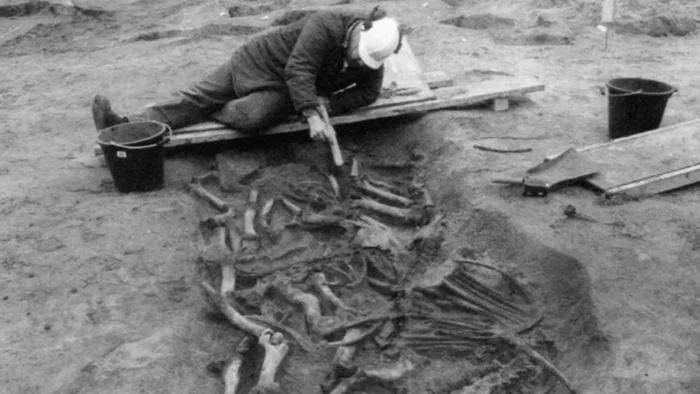In medieval London, horses acted as the vehicular currency of daily life — and thoroughbreds were like pricey exotics.
From the mythical steeds of King Arthur to real, fancy imports like King John’s 100 Flemish stallions, selectively bred horses paced the market. These prized animals came into the possession of knights and nobles for jousting, parading, or purely as status symbols.
But how, and from where? Details remained murky until a recent study, published in the journal Science Advances, keyed in on several 14th- to 16th-century animals’ teeth.
Researchers from the University of Exeter led the work, which focused on a group of horses discovered by accident during construction in the City of Westminster. Found in the 1990s, the site constituted a Tudor cemetery for exotic animals. It was a promising find from the get-go — Westminster was one of the most prolific jousting locations in medieval England, famously hosting King Henry VIII’s 1511 tournament.

Henry VIII showing off for his wife, Katherine of Aragon, at the 1511 Westminster Tournament. Image: College of Arms, Creative Commons
Elite horse-trading
In all, over 70 horses emerged from the site. The recent research examined 22 molars from 15 of them. The team first drilled dental cores from the teeth, then analyzed enamel strontium, oxygen, and carbon isotopes to learn more about the horses’ early lives. With clues about the medieval thoroughbred trade as a target, they sought information about each horse’s birthplace, diet, and mobility.
“Our results provide direct and unprecedented evidence for a variety of horse…trading practices in the Middle Ages and highlight the importance of international trade in high-quality horses for medieval London elites,” the study said.
They found evidence consistent with animals raised on royal stud farms (descendants of which still exist). At these stables, trainers reared young horses for two to three years before either training them for a life on the property or selling them to the highest bidder.
The team found the horses from all over Europe: Scandinavia, the Bohemian Highlands, the Alps, and Scotland, rather than famous hotspots like Andalusia or the Arabian peninsula. The researchers correlated various isotopes in the specimens’ teeth with compounds found in drinking water around Europe.
“Representatives for the King and other medieval London elites were scouring horse trading markets across Europe seeking out the best quality horses they could find and bringing them to London,” Dr. Alex Pryor, the study’s lead author, told SciTechDaily. “It’s quite possible that the horses were ridden in the jousting contests we know were held in Westminster, close to where the horses were buried.”

Horse burial pit under excavation, London. Photo: Museum of London Archaeology
Royal steeds?
Bit wear patterns on the teeth provided insights into the animals’ day-to-day lives and probable capacities. The evidence suggested heavy training with curb bits — a leverage-based piece of kit commonly used on elite horses. Additionally, two of the mares’ molars suggested riding under saddle and, possibly, breeding.
Skeletal analysis showed the steeds were roughly all the same size. Each was big for its day, at about 15 hands (1.6 meters) tall at the shoulder. And fusions in thoracic and lumbar vertebrae were consistent with lives of heavy work and riding.
Taken together, the data indicates elite animals owned by elite individuals — and possibly the royal family itself.






